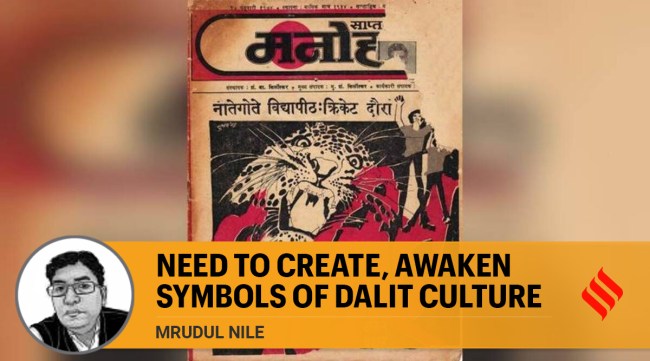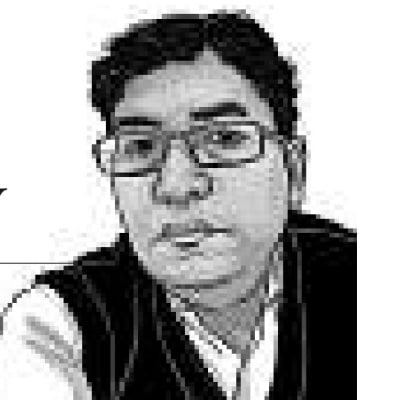Opinion Need to create, awaken symbols of Dalit culture
Mrudul Nile writes: Communities with a history of resistance and struggle celebrate the scars of such struggle which inspires its people. These scars often become the symbols of culture.
 Then young leaders of the Dalit Panthers, Namdeo Dhasal, Arjun Dangle, Raja Dhale and J V Pawar penned the miseries of the Dalit community through their writings, poetry etc. (File)
Then young leaders of the Dalit Panthers, Namdeo Dhasal, Arjun Dangle, Raja Dhale and J V Pawar penned the miseries of the Dalit community through their writings, poetry etc. (File) While Dalits in Maharashtra and particularly Mumbai observe the golden jubilee of the Dalit Panthers, the current generation, who are not a witness to the movement, are gasping in the dark to identify who and which party represents their political aspirations.
Dalit politics in Maharashtra has largely been revolving around the Republican Party of India, which was established by the post-Ambedkar leadership. Dr Ambedkar had indicated his desire to form such a party. But immediately after the establishment of the party, it was broken into factions that continue even today. On the other hand, another popular faction, Vanchit Bahujan Aghadi, too, could not send its representatives to Lok Sabha or the state Assembly in recent elections.
Keeping this background in mind, a study was conducted by me and Shweta Ahire, doctoral scholar at the Department of Civics and Politics, University of Mumbai, to assess political assertion in the Dalit ghettos of Matunga Labour Camp, Ramabai Ambedkar Nagar, P L Lokhande Marg and Shell Colony in Mumbai, alongside pilot work in Marathwada’s Aurangabad.
The objective of the study was to largely assess and understand if political assertion depends on socio-economic and cultural factors. The study revealed that political assertion of Dalits in Mumbai is quite low. Scales were developed to assess socio-economic assertion with urban migration, cultural assertion with Ambedkarism, and political assertion with participating in Dalit movements and creating an alliance between the Left and Ambedkarites.
It was revealed that Dalits perceive electoral politics in isolation and do not link it to socio-economic and cultural development of the community. As a result, organising as a political bloc remains absent in the Dalit ghettos. This remains one of the most important factors responsible for the lack of manifestation of culturalisation.
Culturalisation for the purpose of this study means translation of symbols (for instance, the Bhima Koregoan war memorial or the Chaudar lake in Mahad) into a constructed cultural identity. A better substantiation would be that one observes a large gathering of the Dalit community on the Mahaparinirvan Day on December 6 every year at Chaityabhoomi. However, this emotive element fails to get translated into political outcomes.
Culturalisation is often linked to consciousness. The Dalit community which is considered to be one of the most literate communities, but with no social capital does not have enough opportunities in the current economic system. The common Dalit struggles for his two square meals; the time to develop consciousness and then to translate it into culturalisation remains a slow process.
🚨 Limited Time Offer | Express Premium with ad-lite for just Rs 2/ day 👉🏽 Click here to subscribe 🚨
When Dr Ambedkar converted to Buddhism, he also gave a separate identity (out of the Hindu fold) to the erstwhile untouchables or Dalits. Religion generally generates a separate culture or a community creates new symbols of culture, thus a constructed cultural identity is formed. Moreover, as current politics anchors itself on religion, Buddhism emerges not only as a religious identity but also a political alternative to which the political aspirations are anchored. This cultural identity must be manifested in the modern state at different times, especially during elections.
It was precisely this that the Dalit Panthers achieved. Then young leaders of the Dalit Panthers, Namdeo Dhasal, Arjun Dangle, Raja Dhale and J V Pawar penned the miseries of the Dalit community through their writings, poetry etc, and thus attempted to fill the cultural vacuum that was much needed for the Dalit solidarity. The movement, though, was short lived; its inspiration continues to inspire.
Communities with a history of resistance and struggle celebrate the scars of such struggle which inspires its people. These scars often become the symbols of culture.
Therefore, it is important for the Dalit political parties and candidates to recalibrate political strategy for immediate gains in the elections. But at the same time, it is essential that the cultural movement and the consciousness towards cultural objects (memorials and sites of history of resistance) be manufactured for the Dalit solidarity and consolidation of votes.
A rational political community must be developed in the society so that the Dalit issues are not neglected by the ruling dispensations.
The writer is a professor of civics & politics at the University of Mumbai






